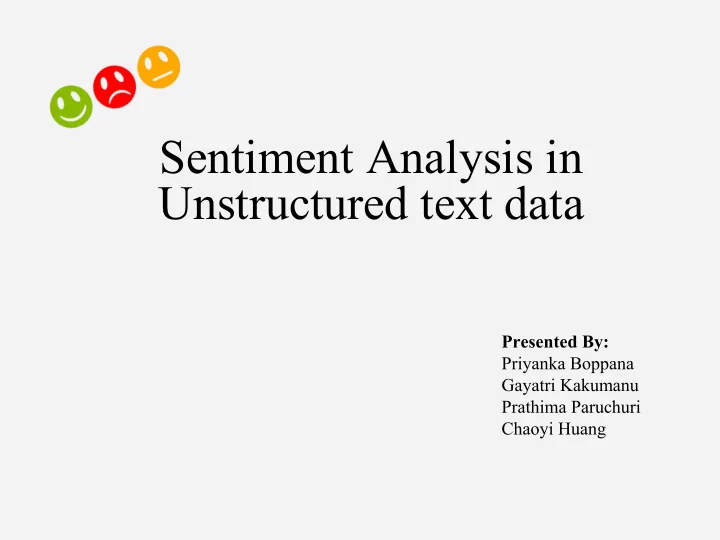

Sentiment Analysis in Unstructured text data Presented By: Priyanka Boppana Gayatri Kakumanu Prathima Paruchuri Chaoyi Huang
Introduction Sentiment Analysis Identify and categorize the opinions expressed in a piece of text • Positive • Negative • Neutral The Sentiment Analysis uses two approaches • Lexicon Based • Machine Learning
Problem Definition: The most common way for people to do sentiment analysis today is Lexicon-based method - by using word dictionary that contains thousands of positive, negative and neutral words to give sentiment score in different texts. This dictionary was generated manually by people, as well as the tag on each words. When we applied this method in unstructured text data, the accuracy of sentiment analysis drop down significantly due to the simple parameters
Machine Learning Definition: Machine learning is the semi-automated extraction of knowledge from data. Main categories of machine learning: 1. Supervised Learning - Making predictions using data. 2. Unsupervised Learning - Extracting structure from data.
Objective: • Is to find out which method is more appropriate for a twitter based unstructured text data between Lexicon-based analysis and some machine learning methods. • Is to improve the accuracy of unstructured data by combining some methods is the goal of our project.
Challenges • Tweets are highly Unstructured @ Listen to #Attention on @AppleMusic’s Global Pop playlist! http://apple.co/28M5kC2 • Lexical Variation @USAirways @AmericanAir #OneHourOnHold,hattttttteeeeee it.
Languages: • R language: Includes all tools necessary for web scraping, familiarity and direct analysis of data.
Proposed Technique: Figure: Systematic procedure for Predicting the data
Dataset American Airline tweets positive sentiment only - contains 336 tweets IMBD movie review - Labeled training set ( 25,000 rows containing an id, sentiment and text for each review ) - Unlabeled training set ( 50,000 rows containing an id and text for each review ) - Test set ( 25,000 rows containing an id and text for each review )
Data-preprocessing 1. Convert all instances to lower cases 2. Removes urls 3. Removes punctuations 4. Removes numbers 5. Removes stopwords 6. Removes extra white spaces
Lexicon-based approach • Dataset: Tweets dataset contains positive sentiments only. • Dictionary: AFINN contains 2700 positive words and 4900 negative words • Accuracy: 73% • Pro: Easy to use • Con: Huge overlap between two classes.
Lexicon-based approach Dataset: IMBD movie review ● Dictionary: AFINN ● Accuracy: 71% ●
Naive Bayes and Unsupervised Learning Approach: Naive Bayes Accuracy: AUC = 0.77516 Approach: Random Forest Accuracy: AUC = 0.7858
Solution 1. Building a Term frequency Matrix from Corpus (75000*213398) 2. Remove all the stop words and the words occur very infrequently 3. Now we have a more manageable 9,799 columns
Contd.. 4. Create a word frequency data frame
Contd.. 5. Now we are building features on words that occur more often in positive review than in negative reviews.
Contd.. 6. We use NDSI, which is the difference of frequencies normalized by their sum. NDSI values are between 0 and 1 with higher values indicating greater correlation with sentiment. 7. We need to penalize infrequent words
Contd.. 8. Apply our unsupervised machine learning (Random forest) AUC = 0.9191
Conclusion and Future work Pros: Higher accuracy, work on large dataset, matrix is easy to create Con: Does not consider word meanings and similarities Future: Adding additional predictors to improve our predictions such as topic modeling and Clustering.
Recommend
More recommend